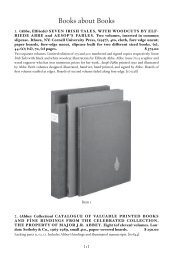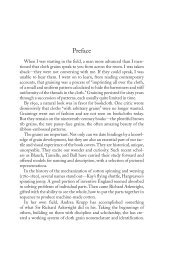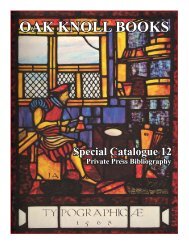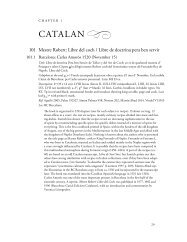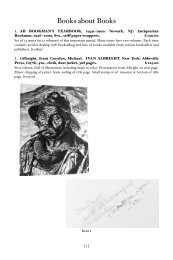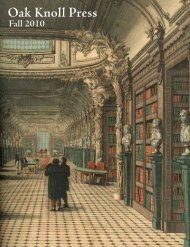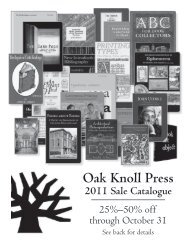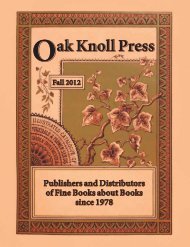Download Printable PDF - Oak Knoll
Download Printable PDF - Oak Knoll
Download Printable PDF - Oak Knoll
Create successful ePaper yourself
Turn your PDF publications into a flip-book with our unique Google optimized e-Paper software.
19. Fichtenberg, M. NEW AND COMPLETE MANUAL ON THE<br />
MAKING OF FANCY PAPERS BY M. FICHTENBERG. Edited by<br />
Richard J. Wolfe. New Castle, Delaware: <strong>Oak</strong> <strong>Knoll</strong> Press, 2010, 5 x 7.25<br />
inches, hardcover. 242 pages.<br />
$ 85.00<br />
This important work was originally written in French by M. Fichtenberg in 1852. Richard<br />
Wolfe has translated the book into English and added a new preface.<br />
The craft of marbling was introduced into Europe and the Middle East from Turkey and<br />
Germany during the last two decades of the sixteenth century, and then into France in the<br />
first decade of the seventeenth century. Other European countries began marbling as well,<br />
but production remained small until its introduction into the British Isles in 1750.<br />
In France, marbling was first performed by bookbinders who catered mainly to the needs of<br />
the book trade. This often meant marbled papers were used for decorating “extra” bindings,<br />
or even sometimes for wallpaper. Fortunately, the nineteenth century saw a change in French<br />
marbling, as they were introduced to a Turkish pattern containing an infusion of turpentine<br />
in the final color. This created an appearance of a network of fine, lacey holes.<br />
New and Complete Manual on the Making of Fancy Papers documents the changes and innovations in French marbling, and describes<br />
the marbling and fancy paper trades of the mid-nineteenth century. It also provides technical details on the manufacture of these<br />
papers and is a key source for information that couldn’t be found anywhere else at the time.<br />
This manual describes many steps in the marbling process. It describes the methods of making colors and the preparation of the<br />
aluminum serving to give body to the colors including reds and violets, yellows, blues, and greens. It discusses the preparation of hide<br />
glue, paste, glue, glazing, polishers, workshops, troughs, papers that are quilted, papers exhibiting the grain of wood, granite papers,<br />
printing, varnishing, sealing wax, and a variety of other details. Four pages of color illustrations complete the book. [106047]<br />
20. Frigge, Karli. SAMPLE BOOK OF THE FANCY PAPER FACTORY ASCHAFFENBURG. Issued<br />
as Volume I in Sample Book series. (Joppe, Netherlands: Frits Knuf, 1993),<br />
narrow 8vo., cloth with paper sample inset on cover, slipcase. (xx), 26+(4) pages.<br />
$ 450.00<br />
Limited edition of 110 signed<br />
and numbered copies. Original<br />
samples of 90 decorated papers<br />
on twenty-six accordion-fold<br />
pages; they cover the 150<br />
year history of this fine paper<br />
factory in Aschaffenburg,<br />
Germany. Karli Frigge<br />
provides a history of the<br />
factory which began in 1811<br />
and closed in 1968. During<br />
this time it was Europe’s<br />
largest factory for decorated,<br />
marbled and embossed papers.<br />
Frigge also describes their<br />
techniques and includes a brief<br />
bibliography. The samples show<br />
marbled papers, paste paper,<br />
roller-printed end-papers,<br />
heavily embossed and rollerembossed<br />
papers, and leather<br />
and wood imitation papers.<br />
[73845]<br />
<strong>Oak</strong> <strong>Knoll</strong> Books Special Catalogue 21



